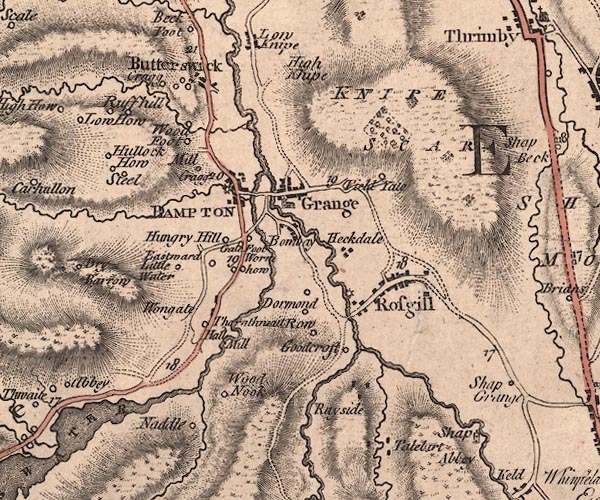




placename:- Noble rough rigge
"Noble rough rigge"
in "Bampton"
placename:- Ruffhill

J5NY51NW.jpg
"Ruffhill"
circle, labelled in italic lowercase text; settlement, farm, house, or hamlet?
item:- National Library of Scotland : EME.s.47
Image © National Library of Scotland
placename:- Rukhole
placename:- Rughole
placename:- Rowgholl
placename:- Roughill
"'The rough hollow'"
"rūh Old English : the adjective describes rugged hill features, especially crags or lower-lying sites that are 'rough' in other senses, perhaps uneven or overgrown. The earliest recorded of about twelve occurrences are ROUGH HILL and ROUGHOLME, both in 13th century documents (though Rougholme may alternatively contain ON rugr 'rye'), One or both of the places named RUTHWAITE may also be a 'rough clearing'."
"hol(h) Old English : (a) the element can be a noun going back to Old Norse hol or Old English hol or holh 'hole, hollow', often referring to a rounded depression or small valley (e.g. FROST HOLE, HOLE HOUSE). The noun form hollow is from holwe, dative singular of Old English holh and only occurs in the plural, in three instances of (HIGH) HOLLOWS. (b) the related adjective goes back to Old Norse holr or Old English hol 'hollowed out' (e.g. HOLE GILL). The adjective form hollow which arose in Middle English also occurs in five names. The element (or group of elements) appears in over a dozen names, and is occasionally reduced to -le as in BROCKLE as opposed to BROCK HOLE (Old English brocc-hol 'badger sett'), or confused with hall (e.g. BAWD HALL), hill (e.g. ROUGH HILL), or how(e) (HOWBURN)."
"later replaced by"
"hill Modern English : Although the standard English 'hill' word (from Old English hyll), and extremely common on English-language place-names of all periods (Gelling 1984, 169-71), this is only about half as common in the Lakeland names as the originally Scandinavian fell. there are some 80 occurrences (sometimes as the first element, e.g. HILL TOP), mainly around the fringes of the high fells. Many names in hill appear first on the 19th century Ordnance Survey maps, but where the name is shared by a settlement it may appear in the 16th century, e.g. HILL, HIGH HILL. Qualifying first elements are normally quite transparent, e.g. GREEN HILL, SAND HILL, WATCH HILL."
courtesy of Diana Whaley and the English Place-Name Society

 Lakes Guides menu.
Lakes Guides menu.